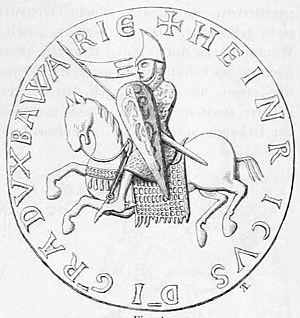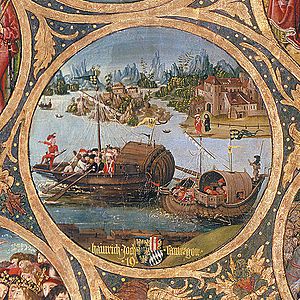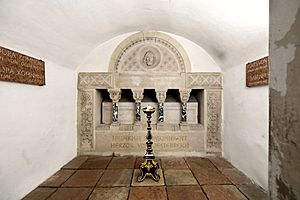Henry II, Duke of Austria facts for kids
Quick facts for kids Henry II Jasomirgott |
|
|---|---|

Effigy on Henry's seal
|
|
| Margrave/Duke of Austria | |
| Reign | 1141–1177 |
| Predecessor | Leopold the Generous |
| Successor | Leopold V |
| Duke of Bavaria | |
| Reign | 1141–1156 |
| Predecessor | Leopold |
| Successor | Henry the Lion |
| Born | 1107 |
| Died | 13 January 1177 (aged 69–70) Vienna, Austria |
| Burial | Schottenstift, Vienna |
| Spouse | Gertrude of Süpplingenburg Theodora Comnena |
| Issue | Agnes, Queen of Hungary Leopold V, Duke of Austria Henry I, Duke of Mödling |
| House | House of Babenberg |
| Father | Leopold III, Margrave of Austria |
| Mother | Agnes of Germany |
Henry II (born 1107, died 13 January 1177), also known as Jasomirgott, was an important ruler from the House of Babenberg. He held several powerful titles during his life. He was the Count Palatine of the Rhine from 1140 to 1141. Later, he became the Duke of Bavaria (as Henry XI) and Margrave of Austria from 1141 to 1156. Most famously, he was the very first Duke of Austria from 1156 until his death.
Contents
Henry's Family and Nickname
Henry was the second son of Margrave Leopold III of Austria. His mother was Agnes of Waiblingen. She was the sister of Emperor Henry V, who was the last emperor from the Salian dynasty. Henry had several important brothers, including Otto of Freising, who was a bishop, and Conrad II, who became an archbishop.
Henry's special nickname, Jasomirgott, first appeared in records in the 1200s. Its exact meaning isn't fully clear. A popular story says it comes from an old German phrase, joch sam mir got helfe, which means "Yes, so help me God."
Becoming a Powerful Ruler
When Henry's father, Leopold III, passed away in 1136, Henry's younger brother, Leopold IV, became the new Margrave. Henry was busy managing his mother's lands in a region called Rhenish Franconia.
In 1140, King Conrad III of Germany gave Henry the title of Count Palatine of the Rhine. Henry held this title for only a short time. In 1141, his brother Leopold IV died unexpectedly. This meant Henry became the new Duke of Bavaria and Margrave of Austria. Leopold IV had received Bavaria in 1139 after King Conrad removed Duke Henry the Proud. This was part of a big argument between two powerful families, the Welfs and the Hohenstaufens.
Henry made the city of Regensburg his home in Bavaria. In 1142, he married Gertrude of Süpplingenburg. She was the daughter of Emperor Lothair and the widow of Henry the Proud. Sadly, Gertrude died less than a year later after giving birth to their only child.
Crusades and New Marriages
Henry was a loyal supporter of the Hohenstaufen family. In 1147, he joined King Conrad on the Second Crusade. This was a major religious war. They faced a terrible defeat against the Seljuk Turks. Henry barely escaped with King Conrad's nephew, Frederick Barbarossa.
After the crusade, Henry visited the court of the Byzantine emperor Manuel I Komnenos. In 1148, Henry married the emperor's niece, Theodora. This marriage showed how important the Babenberg family had become in Central Europe.
Austria Becomes a Duchy
In 1152, Frederick Barbarossa became the new king of Germany. He wanted to make peace with the Welf family. So, in 1156, he gave the Duchy of Bavaria back to Henry the Lion, who was the son of Henry the Proud.
This meant Henry II needed a new important territory. King Frederick solved this with a special document called the Privilegium Minus. This document changed Henry's Margraviate of Austria into a duchy. This new duchy was completely independent from Bavaria. This was a huge step for Austria!
Building Vienna's Importance
Unlike his father, who mostly lived in Klosterneuburg, Henry moved his main home to Vienna in 1145. This decision helped Vienna become the most important city in the duchy. It grew to be more important than other cities like Krems and Melk. Since then, Vienna has remained the capital of Austria.
In 1147, the first St. Stephen's Church was finished. This church became a famous landmark for Vienna. In 1155, Henry also founded the Schottenstift monastery in Vienna. You can still see a statue of him in its courtyard today.
Henry's Final Years
In November 1176, Henry II had an accident near Melk. He fell from a rotten bridge with his horse and broke his hip. Henry II passed away from his injuries on 13 January 1177 in Vienna. He was buried in the Schottenstift monastery, as he had wished.
Henry's Family Life
Henry II was married twice. His first wife was Gertrude of Süpplingenburg. She was the daughter of Emperor Lothair II. They had one child:
- Richenza (born 1143), who married Heinrich Landgraf von Steffling.
His second wife was Theodora Komnene. She was the niece of the Byzantine emperor Manuel I. They had three children:
- Agnes of Austria (around 1154 – 13 January 1182). She married King Stephen III of Hungary and later Duke Herman of Carinthia.
- Leopold V, Duke of Austria (1157 – 31 December 1194). He became the next Duke of Austria.
- Henry I, Duke of Mödling (1158 – 31 August 1223). He married Richeza, daughter of Duke Vladislav II of Bohemia.



